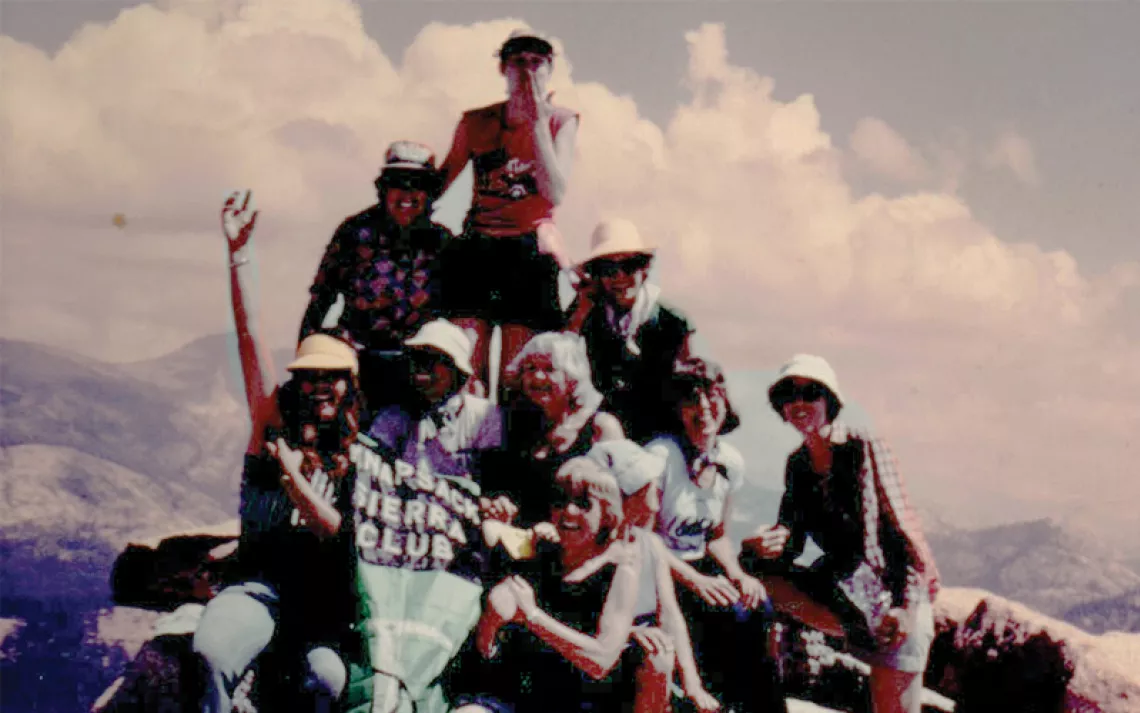Stop Doomscrolling and Submerge Yourself in the Nearest Cave
Explore 24 magical lairs where you won’t have wi-fi!
As the 2020 election lurches toward an outcome, too many of us are glued to our phones and laptops, keeping to a strict 17-second “refresh” cycle. But here’s the truth: Unless you happen to be a ballot counter or an election lawyer, nothing you do, post, or consume is going to change a thing. And while your Twitter followers may “like” your hot takes on the situation, you’re probably not a professional political analyst, either. All that doomscrolling, scientists promise, is leaving us less psychologically prepared to withstand and resist political, climatological, and public health apocalypses.
Instead of letting the doom scroll you, we recommend crawling into a hole. Literally. Not in an avoidant way, of course—it goes without saying that no matter the election results, we environmentalists have our work cut out for us—but in a self-care-in-a-cave way. After all, the wonder to be found in crystal stalagmites and troves of fossils will make you plumb forget about whatever Nate Silver’s been saying. What’s more, America is a veritable wonderland of subterranean exploration, coast to coast, and the mental health benefits of engaging with natural ecosystems are well documented. So why not find your nearest cave, succumb to the peace and serenity of leaving wi-fi and cell connection behind for a couple hours, and head within. (Just remember to bring flashlights, warm clothes, and shoes with good traction!)
Due to COVID-19, many wonderful caves and caverns are temporarily closed (and before heading in and tuning out, you’ll want to check parks’ websites to determine hours and operating status), but still, we uncovered a bevy of deep-earth adventures you can embark on. So stop letting your phone make you batty, and go log some quality time in a cool, calming bat oasis, why don’t you?
ARIZONA
Not far from Benson lies Kartchner Caverns State Park, the former site of a shallow inland sea that 330 million years ago deposited many layers of sediment and fossils. Those layers eventually hardened into limestone, much of which dropped down via a fault thousands of feet below the peaks of the Whetstone Mountains above, forming Kartcher’s vast subterranean network. Once the rooms filled with air, groundwater slowly dripped into the cave, bringing with it minerals that over the years have deposited in the form of a variety of beauteous decorations, called “speleotherms,” over thousands of years. Kartchner Caverns are “living” caves in the sense that these decorations are still actively forming. The cave’s Big Room serves as a nursery roost for more than 1,000 female cave myotis bats who birth pups in late June/early July. Visitors can explore 2.4 miles’ worth of subterranean trails that were discovered by local cave geologists in 1974.
CALIFORNIA
In Siskiyou and Modoc counties, you can explore the many lava tube caves of Lava Beds National Monument. The monument lies on the northeastern flank of Medicine Lake Volcano, and its caves were created 10,500 to 65,000 years ago in the wake of volcanic eruptions—as the lava flowed, it began to cool and solidify, creating large subterranean tubes. Once the eruptions ceased, the tubes emptied and drained, leaving behind dozens of caves, 25 of which have marked entrances, developed trails, and in some cases, stairways and ladders for increased accessibility. Most of the developed caves are located along Cave Loop, a two-mile road near the monument’s visitor center (where you must stop to get screened and make sure you’re not a carrier for white-nose syndrome, a deadly fungal bat disease). Just a short walk from the visitor center, Mushpot Cave contains exhibits and is the only lighted cave at Lava Beds. Lava Beds’ developed caves are divided into three groups based on their varying levels of exploration difficulty: least, moderate, and most challenging. (Claustrophobes beware—some among the latter category require some belly-sliding on ice. Our favorite is the Heppe Ice Cave Trail, which leads directly into Heppe Cave.) Many of the faves were badly burned in recent California wildfires but in some ways, it makes them appear all the more spectacular, by exposing more lava. These tubes are not only cell-service-free; they’re hotbeds of unique cave life—while exploring, you may be lucky enough to spot cave crickets, rubber boas, millipedes, or bats.
Not too far away, in the foothills of Mount Shasta and 900 feet above Shasta Lake, Lake Shasta Caverns National Natural Landmark offers another geologic adventure. Take a guided catamaran ride across the lake and a bus tour around it (where guests frequently spot bald eagles, mountain lions, and black bears) before exploring the caverns below, which originated 250 million years ago when the Earth’s crust folded in on itself, creating the Klamath Mountains. The resulting caverns, which feature tiny cave coral and gravity-defying helicities, were inhabited by the area's original inhabitants, the Wintu Indians. Once Indigenous populations were driven out, the caverns remained unknown until 1878, when an employee of the nearby McCloud River’s fish hatchery, re-discovered them.
South of San Jose, the Bear Gulch and Balconies Caves of Pinnacles National Park were formed in the late ice age, when steep, narrow canyons became filled with a jumbled mass of boulders from the cliffs above, creating all manner of faults and fractures in the volcanic rock. These dynamic talus caves continue to morph and weather as the earth roils below, and gravel and sand become lodged between the boulders, where they tend to erode during the flash floods that occasionally rush through the caves. Allegedly, these caves were used as a hideout by notorious 19th-century bandito Tiburcio Vasquez, who was hanged in San Jose in 1875—leading to much speculation about buried cave treasure. In the 1930s, the Civilian Conservation Corps built trails through Pinnacles’ caves, constructing stairways and bridges so that visitors could explore without needing ropes and ladders.
COLORADO
Ideal for that cross-section of fun-lovers who adore natural splendor and theme park kitsch, Glenwood Caverns and Historic Fairy Caves (pictured below) are located high atop Iron Mountain in Glenwood Springs. Formed by Colorado River water runoff mixed with mineral hot springs, these caves’ walls are notably vibrant. With their steady 52°F temperature and lack of cell reception, they make for great respites from Colorado’s toasty summers and chilly winters, and smartphone alerts of all kinds. To access the sumptuously bizarre wonderland within, you have to buy a ticket and ride a gondola all the way up the mountain. There, you can take guided tours of the caves, ride an alpine coaster and a “haunted drop” down an old-timey mine shaft, play cave laser tag, and catch light shows highlighting the caves’ most striking stalactites, stalagmites, water features, and “cave bacon.” While currently closed, the Glenwood Caverns will open for its winter season, at limited capacity, on Friday, November 13.

FLORIDA
Circa prehistoric times, a karst window (that’s the roof over a subterranean river) collapsed near Williston, Florida, exposing the water to open surface. In winter, the water vapor rising from the surface of the river forms a visible plume above the entrance to the resulting cave, causing early settlers of the area to dub the feature “Devil’s Den.” In the 1990s, the solution sinkhole that creates an opening to Devil’s Den Spring was enlarged, creating an inverted mushroom cave below water level, and a popular inland spot for scuba diving and snorkeling. Four passages under the site’s crystal-clear, 72-degree water extend through ancient stalactites from the crystal-clear—and contain the remains of humans dating from 7500 BC, as well as mastodons, ground sloths, camels, horses, dire wolves, bog lemmings, saber-toothed cats, and peccaries.
Cave diving is notoriously dangerous, but apparently very rewarding, and Florida is something of a mecca—divers who’ve explored this and other caves in the Sunshine State, including Ginnie Springs, Blue Grotto, and Peacock Springs—have reported venturing through narrow tunnels to emerge into stadium-sized interior caverns where they’ve spotted the fossils of whale bones!
HAWAII
On the Big Island near Hilo, Kaumana Caves State Park features a metal ladder that descends into a lava tube created by an 1881 lava flow from Mauna Loa. Though you’ll want to bring a flashlight into this dark underworld, you won’t need to pay any admission fees.
IDAHO
Outside Rexburg, Idaho’s Civil Defense Caves consist of large tubes formed from lava. They got their intense name during the Cold War era, when caves were seen as great places to store sensitive materials, shelter from bombs, and build military prisons. These caves never ended up being used for defense purposes, but they still make for good places to get away from all the figurative nukes going off in your phone. Even in the summer, these caves can be icy, so bring solid footwear and jackets!
KENTUCKY
Beneath a swath of Kentucky Hills and hollows lies a limestone labyrinth containing over 400 miles’ worth of immense subterranean rooms and tight passageways that twist and turn through the earth’s crust. Indeed, the world’s largest known contiguous cave network lies within Mammoth National Park. Described by famous caver and former slave Stephen Bishop as a “grand, gloomy, and peculiar place,” these caves are smooth and relatively free of stalagmites and stalactites, thanks to Mammoth’s giant roof of shale and sandstone underlying the hilly aboveground woodlands. These layers prevent much of the water drip that’s typical at over caves (except beneath a few odd sinkholes, where surface water has eroded the limestone into a honeycomb of elaborate caverns). With an abundance of self-guided exploration opportunities and ranger-led tours, the selection of which changes seasonally and with staffing availability, you’ll want to read descriptions and learn about cave tours before planning your park trip. If you really want to see stalagmites and stalactites, we recommend the Frozen Niagara or Domes and Dripstone Tours. The comprehensive Historic Tour is a solid, family-friendly intro to cave geology, and the more strenuous four-mile-long Grand Avenue Tour lets you climb subterranean mountains. The toughest challenge (and most serious respite from your phone) lies in the five-mile, six-hour, belly-brawling Wild Cave Tour.
MASSACHUSETTS
Just southwest of Woucester, Sutton’s Purgatory Chasm State Reservation offers two miles’ worth of trails leading to rock formations like the Corn Crib, the Coffin, and Lovers’ Leap. It’s all thanks to a mile-high glacier that set loose a gush of damned-up water some 14,000 years ago, carving out Purgatory’s 70-foot-deep chasm. (Be aware that the descent into the quarter-mile-long chasm requires both hands, a steady heart, and hiking shoes with good traction!)
MINNESOTA
Seeking an adventure in the bedrock of Soudan ore deposits? Check out Lake Vermilion-Soudan Underground Mine State Park, where ancient seas and volcanoes deposited Soudan ore some 2.7 billion years ago. It all folded and compressed into subterranean mountain ranges, further shaped by glaciers flowing down from the Arctic. The last glacier exposed an outcrop of rich hematime near Lake Vermilion that later became the Soudan Mine. In 1884 it became Minnesota’s first Iron Ore Mine, which was turned into a protected state park in 1963. In the 1980s, scientists from the University of Minnesota began to develop the Soudan Mine as a site for sensitive physics experiments, because of the very low rate of cosmic rays in the deep underground site. Today, visitors can slip on a hard hat and take self-guided audio tours of the mining operations, or embark on exciting guided tours. We guarantee your phone won’t work down there.
MISSOURI
Just south of storied Hannibal, Missouri, bookworms and outdoor adventurers alike flock to the Mark Twain Cave Complex. Originally named McDougal’s Cave, these caverns were a key feature in Twain’s novel The Adventures of Tom Sawyer, and were thus rechristened so as to honor the author in 1880. The oldest “show cave” in the state, guests have been touring these narrow, winding passages, made from soft limestone, since 1886. While it’s possible that early Indigenous habitants were aware of the cave, the earliest documentation credits its discovery to local hunter Jack Simms, whose dog chased an animal into a small hillside opening in the winter of 1819. Investigating with torches, Simms and his brothers uncovered the large underground labyrinth that went on to become a secret cache for Confederate weapons, a mad scientist’s literal lair, and a popular diversion for the children of Hannibal, including a young Twain (nee Sam Clemens), who later fictionalized those cave adventures in his novels.
NEW MEXICO
Hidden beneath the surface of the Chihuahuan Desert are the 119 caves comprising Carlsbad Caverns National Park. Come at dawn to witness thousands of bats returning to the caves, or anytime to explore the 1.25-mile Big Room Trail, which takes you through North America’s largest single cave chamber, famously described by comedian Will Rogers as “the Grand Canyon with a roof over it.” Indeed, the Big Room offers spectacular views, and geologic formations of all shapes and sizes. The more daunting Natural Entrance Trail takes you 75 stories deep into the Earth, and past singular formations like Devil’s Spring, the Whale’s Mouth, and Iceberg Rock.
Not ready to be back aboveground yet? Venture west of Albequerque to El Malpais and El Morro National Monuments, where you can explore miles’ worth of lava tube caves.
NEW YORK
Fans of haunted houses, escape rooms, and weddings performed atop calcite formations resembling a heart shape will love upstate New York’s Howe Caverns, where geology meets showbiz. Geologists believe this cave, which lies 156 below ground, formed several million years ago. Composed of two types of limestone from different periods in the earth’s early history, the cave contains a lake (the Lake of Venus), as well as many fetching speleotherms. The caverns are named after farmer Lester Howe, who discovered the cave in 1852 after noticing that on hot days, his cows would gather near a breezy hole in the earth obscured by some bushes. To this day, the cave remains at a constant temperature of 52 degrees Fahrenheit, all four seasons long. Today, the two-hour “Signature Rock Discovery Tour” simulates natural cave exploration, but with the assistance of a guide. Visitors are equipped with suits appropriate for the cold, muddy journey, and get to visit the remains of Howe’s original tourist bat, the signatures etched into rock by cavern adventurers from over 100 years ago, and a “Music Hall” where sound echoes exceptionally well. The tour concludes at the “Lake of Mystery,” and of course, a stop at the gift shop, known for its “cave-aged” cheese.
OKLAHOMA
Alabaster Caverns State Park contains the world’s largest natural gypsum caves, which are composed of rare black alabaster and white and pink crystal. These caverns formed over 200 million years ago, during the Permian Age, when Oklahoma was covered by inland sea. When the water eventually evaporated, huge deposits of alabaster and other minerals, left behind, became caves when water streams tunneled through, creating the resulting formations. In the 19th century, Alabaster Caverns served as hideouts for outlaws. Today, daily guided tours take guests along well-lit interpretive paths. Seasoned cavers can go in for “wild caving,” or spelunking, through the caverns, which range in length from 550 feet to 1600 feet.
UTAH
Little-known fact: You don’t have to go to a coast or island to snorkel or even scuba dive in the US. In what’s now Midway, Utah, a crater formed over 10,000 years ago, when snow melted off the Wasatch Mountains and seeped two miles into the earth. There it heated the water, creating a geothermal spring within a 55-foot-tall beehive-shaped limestone deposit called the Homestead Crater. The hole at the top of the dome lets in sunlight and fresh air (but little to no cell reception), while the interior stays heated by the mineral water at a constant range of 90 to 96 degrees Fahrenheit. Guests of the surrounding Midway Utah Resort, as well as day visitors, can take self-guided crater tours, venture into a tunnel through the rock well, and soak, swim dive, snorkel or even practice paddle-board yoga in the crater’s warm, crystal-clear waters.
For another deep dive into Utah’s surprise ocean, check out the nearby Bonneville Seabase, where the Las Vegas’s retired “showfish” (largely sting rays and nurse sharks), plus critters donated from animal rescues, find refuge. The subterranean waters here have the same salinity as the Caribbean, and tunnels connect the shallow White Rocks pool with the half-acre Habitat Bay and The Abyss, a deepwater silo. Yes, divers can find a splash of the tropics in the high desert.
VIRGINIA
The largest network of caverns in the Eastern US are also among the most accessible (no stairs!), and, well, civilized. Luray Caverns offer lighted, paved walkways through cathedral-sized caverns (some with ceilings 10 stories high), and towering stone formations. Generously adorned with speleothems including columns, mud flows, stactites, stalagmites, flowstone, and mirrored pools, these caverns are best known for wild features including the Great Stalacpipe Organ, a lithophone made solenoid-fired strikers that tap stalactites of various sizes to produce tones similar to those made by xylophones. Further otherworldly gems include Dream Lake, the Fried Eggs rock formations, The Saracen’s Tent, a Wishing Well, and a war memorial honoring veterans from local Page County. They all take but an hour to explore—making for an ideal mental health break from incessant social media and news notifications.
WEST VIRGINIA
In Greenbrier County, national natural landmark Organ Cave contains more than 45 miles of mapped passages. The site of the discovery of the first prehistoric three-toed sloth fossils, the East Coast’s second-longest commercial cave is also a hot spot for hobby paleontologists. From November through April, all guided walking tours and spelunking adventures require reservations. Guests get to learn about Organ Cave’s role in the American Civil War, gain an understanding of cave ecology, likely spy some bats, and get to forget all about their phones and the daily news cycle.
 The Magazine of The Sierra Club
The Magazine of The Sierra Club




